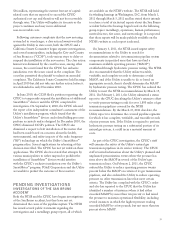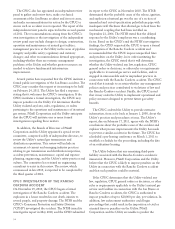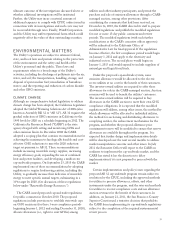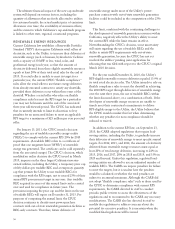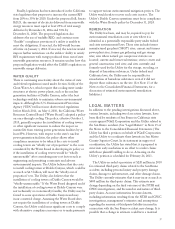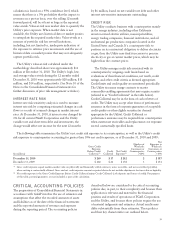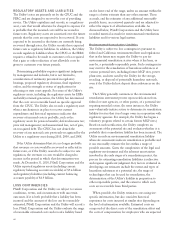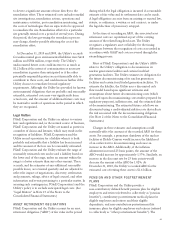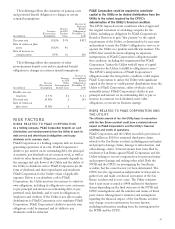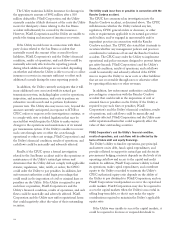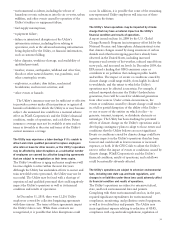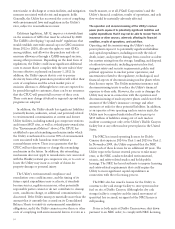PG&E 2010 Annual Report Download - page 47
Download and view the complete annual report
Please find page 47 of the 2010 PG&E annual report below. You can navigate through the pages in the report by either clicking on the pages listed below, or by using the keyword search tool below to find specific information within the annual report.
The following reflects the sensitivity of pension costs
and projected benefit obligation to changes in certain
actuarial assumptions:
(in millions)
Increase
(Decrease) in
Assumption
Increase
in 2010
Pension
Costs
Increase in
Projected
Benefit
Obligation at
December 31,
2010
Discount rate (0.5)% $ 78 $ 872
Rate of return on plan
assets (0.5)% 46 –
Rate of increase in
compensation 0.5% 36 206
The following reflects the sensitivity of other
postretirement benefit costs and accumulated benefit
obligation to changes in certain actuarial assumptions:
(in millions)
Increase
(Decrease) in
Assumption
Increase
in 2010
Other
Postretirement
Benefit Costs
Increase in
Accumulated
Benefit
Obligation at
December 31,
2010
Health care cost
trend rate 0.5 % $ 4 $ 41
Discount rate (0.5)% 2 103
Rate of return on
plan assets (0.5)% 6 –
RISK FACTORS
RISKS RELATED TO PG&E CORPORATION
As a holding company, PG&E Corporationdepends oncash
distributionsandreimbursements from the Utility to meet its
debt service and otherfinancial obligationsand to pay
dividends onits commonstock.
PG&E Corporation is a holding company with no revenue
generating operations of its own. PG&E Corporation’s
ability to pay interest on its outstanding debt, the principal
at maturity, pay dividends on its common stock, as well as
satisfy its other financial obligations, primarily depends on
the earnings and cash flows of the Utility and the ability of
the Utility to distribute cash to PG&E Corporation (in the
form of dividends and share repurchases) and reimburse
PG&E Corporation for the Utility’s share of applicable
expenses. Before it can distribute cash to PG&E
Corporation, the Utility must use its resources to satisfy its
own obligations, including its obligation to serve customers,
to pay principal and interest on outstanding debt, to pay
preferred stock dividends, and to meet its obligations to
employees and creditors. If the Utility is not able to make
distributions to PG&E Corporation or to reimburse PG&E
Corporation, PG&E Corporation’s ability to meet its own
obligations could be impaired and its ability to pay
dividends could be restricted.
PG&E Corporationcould be required to contribute
capital to the Utility orbe denied distributionsfrom the
Utility to the extentrequired by the CPUC’s
determinationof the Utility’s financial condition.
The CPUC imposed certain conditions when it approved
the original formation of a holding company for the
Utility, including an obligation by PG&E Corporation’s
Board of Directors to give “first priority” to the capital
requirements of the Utility, as determined to be necessary
and prudent to meet the Utility’s obligation to serve or to
operate the Utility in a prudent and efficient manner. The
CPUC later issued decisions adopting an expansive
interpretation of PG&E Corporation’s obligations under
this condition, including the requirement that PG&E
Corporation “infuse the Utility with all types of capital
necessary for the Utility to fulfill its obligation to serve.”
The CPUC’s interpretation of PG&E Corporation’s
obligation under the first priority condition could require
PG&E Corporation to infuse the Utility with significant
capital in the future or could prevent distributions from the
Utility to PG&E Corporation, either of which could
materially restrict PG&E Corporation’s ability to pay
principal and interest on its outstanding debt or pay or
increase its common stock dividend, meet other
obligations, or execute its business strategy.
RISKS RELATED TO PG&E CORPORATION AND
THE UTILITY
The ultimate amount of loss the Utility bearsinconnection
with the SanBruno accident could have a material adverse
impact onPG&E Corporation’s and the Utility’s financial
conditionandresults of operations.
PG&E Corporation and the Utility recorded a provision of
$220 million in 2010 for estimated third-party claims
related to the San Bruno accident, including personal injury
and property damage claims, damage to infrastructure, and
other damage claims. Various lawsuits have been filed by
residents of San Bruno against PG&E Corporation and the
Utility seeking to recover compensation for personal injury
and property damage and seeking other relief. Both the
NTSB and the CPUC are investigating the San Bruno
accident, but the cause has not yet been determined. The
CPUC has also appointed an independent review panel to
gather facts and make a technical assessment of the San
Bruno accident and its root cause. The Utility estimates
that it may incur as much as $400 million for third-party
claims depending on the final outcome of the NTSB and
CPUC investigations and the number and nature of third-
party claims. Management’s estimates and assumptions
regarding the financial impact of the San Bruno accident
may change as more information becomes known,
including information resulting from the investigations by
the NTSB and the CPUC.
43


